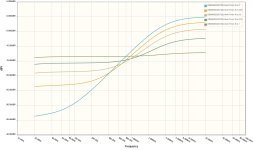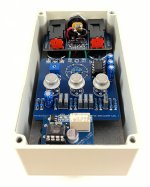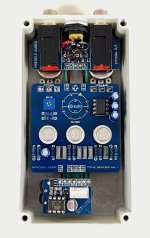PedalBuilder
Well-known member
- Build Rating
- 5.00 star(s)
After building a Dizzy Tone and a Buzzaround, I set my eyes on their close cousin, the Tone Bender Mk. III. Like most early fuzz pedals, the component values of the Tone Bender Mk. III and its variants changed frequently during their relatively short production period. Some values remained constant, but others (the RefDes values in this schematic) changed from one version to another.
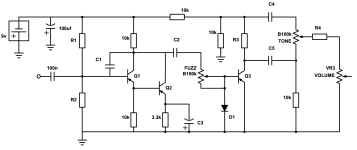 I highly recommend looking at Andrew's write-up on the different Mk. III versions at Vero-P2P, which includes a handy table for seeing how component values differed from one version to another. As you can see, there are quite a few options to choose from!
I highly recommend looking at Andrew's write-up on the different Mk. III versions at Vero-P2P, which includes a handy table for seeing how component values differed from one version to another. As you can see, there are quite a few options to choose from!
I started off by breadboarding the standard circuit using the Sola Sound Tone Bender values. Off the bat, I really liked the texture of the distortion, but found the overall sound thinner and quieter than I would like, even with the volume control maximized. I recalled hearing that the DAM Fuzz Sound versions had been designed to address these issues, so I pulled their values from the table, increasing C4 to 220nF and C5 to 4.7nF, and decreasing R4 to 10k. Those changes did a lot to thicken up the tone, perhaps too much, as it was now slightly boomy. I tried reducing C4 to 180nF, which thinned out the tone more than I wanted, while doing nothing about the unwanted boominess. I ended up reducing C3 to 4.7µF, while keeping the 220nF, which removed the boominess while keeping the tone nice and thick.
Unfortunately, the maximum volume was still slightly below unity gain. To increase the output level, I split the 18k resistor in R3 into two resistors (8.2k and 10k). This reduced the attenuation on the bass side of the tone circuit, while keeping the Q3 bias unchanged. As you can see in the simulation below, the output level of the modification is significantly louder than the original.
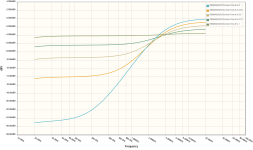
The modification slightly changed the midrange behavior of the tone control, but I liked the results and decided to keep it. Here's the resulting schematic:
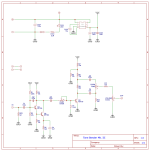
On the active component side of things, I used IPRS Romanian transistors—a pair of EFT83 transistors for Q1 and Q2, and an ACY33 for Q3. Specs for the transistors are:
Q1: EFT83, hFE 59, leakage 67µA
Q2: EFT83, hFE 52, leakage 70µA
Q3: ACY33, hFE 204, leakage 279µA
Tested on a Peak DCA55 at 70ºF
I tried a bunch of different diodes, ultimately settling on a D18, a cool-looking, oversized Soviet germanium diode. (In this type of a circuit, the diode is at least as important as Q3. Its leakage works with Q3's leakage to set the Q3's bias, so it's worth taking the time to experiment with different diodes.)
So, on to the build:
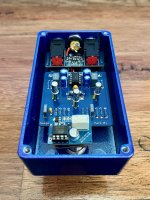
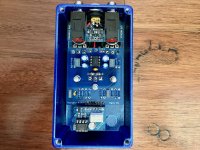

Aesthetically I was going for something that borrowed a bit from the Sola Sound Tone Bender and the Colorsound Fuzz Sound. The enclosure is a Tayda 125B in Metallic Candy Blue. Artwork is UV printed, with two passes of white and a matte finish.
Soundwise, this thing sounds surprisingly modern for a pedal that was originally released in 1968. It's got a much tighter feel, less like a fuzz and more like a distortion.
 I highly recommend looking at Andrew's write-up on the different Mk. III versions at Vero-P2P, which includes a handy table for seeing how component values differed from one version to another. As you can see, there are quite a few options to choose from!
I highly recommend looking at Andrew's write-up on the different Mk. III versions at Vero-P2P, which includes a handy table for seeing how component values differed from one version to another. As you can see, there are quite a few options to choose from! I started off by breadboarding the standard circuit using the Sola Sound Tone Bender values. Off the bat, I really liked the texture of the distortion, but found the overall sound thinner and quieter than I would like, even with the volume control maximized. I recalled hearing that the DAM Fuzz Sound versions had been designed to address these issues, so I pulled their values from the table, increasing C4 to 220nF and C5 to 4.7nF, and decreasing R4 to 10k. Those changes did a lot to thicken up the tone, perhaps too much, as it was now slightly boomy. I tried reducing C4 to 180nF, which thinned out the tone more than I wanted, while doing nothing about the unwanted boominess. I ended up reducing C3 to 4.7µF, while keeping the 220nF, which removed the boominess while keeping the tone nice and thick.
Unfortunately, the maximum volume was still slightly below unity gain. To increase the output level, I split the 18k resistor in R3 into two resistors (8.2k and 10k). This reduced the attenuation on the bass side of the tone circuit, while keeping the Q3 bias unchanged. As you can see in the simulation below, the output level of the modification is significantly louder than the original.

The modification slightly changed the midrange behavior of the tone control, but I liked the results and decided to keep it. Here's the resulting schematic:

On the active component side of things, I used IPRS Romanian transistors—a pair of EFT83 transistors for Q1 and Q2, and an ACY33 for Q3. Specs for the transistors are:
Q1: EFT83, hFE 59, leakage 67µA
Q2: EFT83, hFE 52, leakage 70µA
Q3: ACY33, hFE 204, leakage 279µA
Tested on a Peak DCA55 at 70ºF
I tried a bunch of different diodes, ultimately settling on a D18, a cool-looking, oversized Soviet germanium diode. (In this type of a circuit, the diode is at least as important as Q3. Its leakage works with Q3's leakage to set the Q3's bias, so it's worth taking the time to experiment with different diodes.)
So, on to the build:



Aesthetically I was going for something that borrowed a bit from the Sola Sound Tone Bender and the Colorsound Fuzz Sound. The enclosure is a Tayda 125B in Metallic Candy Blue. Artwork is UV printed, with two passes of white and a matte finish.
Soundwise, this thing sounds surprisingly modern for a pedal that was originally released in 1968. It's got a much tighter feel, less like a fuzz and more like a distortion.


